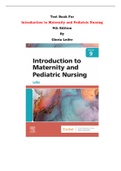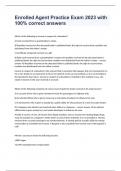-
1. Exam (elaborations) - Test bank for maternal child nursing care 7th edition by shannon e. perry, marilyn j....
-
2. Exam (elaborations) - Test bank for lewis's medical-surgical nursing 12th edition by mariann m. harding, je...
-
3. Exam (elaborations) - Test bank for leading and managing in nursing 8th edition by patricia s. yoder-wise, ...
-
4. Exam (elaborations) - Test bank for pharmacology a patient-centered nursing process approach 11th edition b...
-
5. Exam (elaborations) - Test bank for dewits medical surgical nursing concepts and practice 4th edition by h...
-
6. Exam (elaborations) - Test bank for fundamentals of nursing 9th edition by carol taylor, pamela lynn, jenn...
-
7. Exam (elaborations) - Test bank for community and public health nursing 10th edition by cherie. rector, ma...
-
8. Exam (elaborations) - Test bank for clinical manifestations and assessment of respiratory disease 8th edit...
-
9. Exam (elaborations) - Test bank for medical-surgical nursing: assessment and management of clinical problem...
-
10. Exam (elaborations) - Test bank for gould's pathophysiology for the health professions 7th edition by karin...
-
11. Exam (elaborations) - Test bank for basic pharmacology for nurses 19th edition by michelle willihnganz, sa...
-
12. Exam (elaborations) - Test bank for contemporary nursing issues, trends, & management 9th edition by barba...
-
13. Exam (elaborations) - Test bank for introduction to maternity and pediatric nursing 9th edition by gloria ...
-
14. Exam (elaborations) - Test bank for professional nursing: concepts & challenges 9th edition by beth black ...
-
15. Exam (elaborations) - Test bank for maternal & child health nursing care of the childbearing & childrearin...
-
16. Exam (elaborations) - Test bank for maternal-child nursing 6th edition by emily slone mckinney, susan r. ja...
-
17. Exam (elaborations) - Test bank for bates’ guide to physical examination and history taking 13th edition ...
-
18. Exam (elaborations) - Test bank for williams’ basic nutrition and diet therapy 16th edition by staci nix ...
-
19. Exam (elaborations) - Test bank for seidel's guide to physical examination an interprofessional approach 1...
-
20. Exam (elaborations) - Test bank for fundamentals of nursing active learning for collaborative practice 3rd ...
-
21. Exam (elaborations) - Test bank for psychiatric nursing contemporary practice 7th edition by mary ann boy...
-
22. Exam (elaborations) - Test bank for jarvis physical examination and health assessment 8th edition by caroly...
-
23. Exam (elaborations) - Test bank for lehne's pharmacology for nursing care 11th edition by jacqueline burch...
-
24. Exam (elaborations) - Test bank for varcarolis' foundations of psychiatric mental health nursing: a clinica...
-
25. Exam (elaborations) - Test bank for medical surgical nursing concepts for interprofessional collaborative ...
-
26. Exam (elaborations) - Test bank for textbook of basic nursing 11th edition by caroline bunker rosdahl, mar...
-
27. Exam (elaborations) - Test bank for pharmacology and the nursing process 9th edition by linda lane lilley,...
-
28. Exam (elaborations) - Test bank for nutritional foundations and clinical applications a nursing approach ...
-
29. Exam (elaborations) - Test bank for porth’s essentials of pathophysiology 4th edition by tommie l.norris...
-
30. Exam (elaborations) - Test bank for porth’s pathophysiology concepts of altered health states 10th edit...
-
31. Exam (elaborations) - Test bank for fundamentals of nursing 10th edition by potter perry |all chapters, co...
-
32. Exam (elaborations) - Test bank for hamric & hanson's advanced practice nursing an integrative approach 7t...
-
33. Exam (elaborations) - Test bank for health assessment for nursing practice 7th edition by susan fickertt wi...
-
34. Exam (elaborations) - Test bank for foundations for population health in community public health nursing 5t...
-
35. Exam (elaborations) - Test bank for gerontological nursing 10th edition by charlotte eliopoulos |all chapte...
-
36. Exam (elaborations) - Test bank for essentials of pediatric nursing 4th edition by theresa kyle, susan carm...
-
37. Exam (elaborations) - Test bank for pharmacology clear and simple a guide to drug classifications and dosa...
-
38. Exam (elaborations) - Test bank for abrams’ clinical drug therapy rationales for nursing practice 12th ...
-
39. Exam (elaborations) - Test bank for understanding pathophysiology 7th edition by sue e. huether, kathryn l...
-
40. Exam (elaborations) - Test bank for principles of anatomy and physiology 16th edition by gerald tortora, b...
-
41. Exam (elaborations) - Test bank for pharmacotherapeutics for advanced practice nurse prescribers 5th editi...
-
42. Exam (elaborations) - Test bank for medical-surgical nursing 7th edition by adrianne linton, mary ann matt...
-
43. Exam (elaborations) - Test bank for fundamentals of nursing care concepts, connections & skills 3rd edition...
-
44. Exam (elaborations) - Test bank for success in practical vocational nursing from student to leader 9th edit...
-
45. Exam (elaborations) - Test bank for pharmacotherapeutics for advanced practice a practical approach 5th edi...
-
46. Exam (elaborations) - Test bank for beckmann and ling's obstetrics and gynecology 8th edition by robert ca...
-
47. Exam (elaborations) - Test bank for understanding pharmacology essentials for medication safety 2nd edition...
-
48. Exam (elaborations) - Test bank for burns and grove's the practice of nursing research 9th edition by jenn...
-
49. Exam (elaborations) - Test bank for principles of pediatric nursing caring for children 7th edition by ja...
-
50. Exam (elaborations) - Test bank for applied pathophysiology a conceptual approach to the mechanisms of di...
-
51. Exam (elaborations) - Test bank for growth and development across the lifespan 2nd edition by gloria lei...
-
52. Exam (elaborations) - Test bank for basic geriatric nursing 7th edition by patricia a. williams |all chapt...
-
53. Exam (elaborations) - Test bank for philosophies and theories for advanced nursing practice 3rd edition by...
-
54. Exam (elaborations) - Test bank for concepts for nursing practice 3rd edition by jean foret giddens |all ch...
-
55. Exam (elaborations) - Test bank for nursing delegation and management of patient care 2nd edition by kathle...
-
56. Exam (elaborations) - Test bank for maternity and women's health care 12th edition by deitra leonard lowde...
-
57. Exam (elaborations) - Test bank for essentials of psychiatric mental health nursing a communication approa...
-
58. Exam (elaborations) - Test bank for burns' pediatric primary care 7th edition by dawn lee garzon maaks, na...
-
59. Exam (elaborations) - Test bank for community public health nursing 7th edition by mary a. nies, melanie m...
-
60. Exam (elaborations) - Test bank for applied pathophysiology for the advanced practice nurse 1st edition b...
-
61. Exam (elaborations) - Test bank for medical-surgical nursing concepts for interprofessional collaborative ...
-
62. Exam (elaborations) - Test bank for introductory maternity and pediatric nursing 4th edition by nancy t. h...
-
63. Exam (elaborations) - Test bank for maternity and pediatric nursing 3rd edition by susan scott ricci, susan...
-
64. Exam (elaborations) - Test bank for psychiatric-mental health nursing 8th edition by shelia videbeck |all ...
-
65. Exam (elaborations) - Test bank for pathophysiology the biologic basis for disease in adults and children ...
-
66. Exam (elaborations) - Test bank for primary care: art and science of advanced practice nursing - an interpr...
-
67. Exam (elaborations) - Test bank for basic nursing thinking doing and caring 2nd edition by leslie s. trea...
-
68. Exam (elaborations) - Test bank for foundations of maternal-newborn and women's health nursing 7th edition ...
-
69. Exam (elaborations) - Test bank for lehne's pharmacotherapeutics for advanced practice nurses and physician...
-
70. Exam (elaborations) - Test bank for maternal-newborn nursing: the critical components of nursing care 3rd ...
-
71. Exam (elaborations) - Test bank for leadership roles and management functions in nursing theory and applica...
-
72. Exam (elaborations) - Test bank for wong's nursing care of infants and children 11th edition by marilyn j. ...
-
73. Exam (elaborations) - Test bank for focus on nursing pharmacology 8th edition by rebecca tucker, amy m. ka...
-
74. Exam (elaborations) - Test bank for essentials of maternity newborn and women's health nursing 5th edition ...
-
75. Exam (elaborations) - Test bank for essentials of psychiatric mental health nursing 8th edition by karyn i...
-
76. Exam (elaborations) - Test bank for pediatric nursing the critical components of nursing care 2nd edition...
-
77. Exam (elaborations) - Test bank for understanding medical surgical nursing 6th edition by linda s. william...
-
78. Exam (elaborations) - Test bank for the human body in health and disease 8th edition by kevin t. patton, fr...
-
79. Exam (elaborations) - Test bank for essentials for nursing practice 9th edition by patricia a. potter, anne...
-
80. Exam (elaborations) - Test bank for understanding nursing research building an evidence-based practice 7th ...
-
81. Exam (elaborations) - Test bank for roach’s introductory clinical pharmacology 11th edition by susan m. f...
-
82. Exam (elaborations) - Test bank for psychiatric mental health nursing: concepts of care in evidence-based p...
-
83. Exam (elaborations) - Test bank for microbiology: an introduction 13th edition by gerard tortora , berdell...
-
84. Exam (elaborations) - Test bank for maternity and pediatric nursing 4th edition by susan scott ricci, susan...
-
85. Exam (elaborations) - Test bank for advanced practice nursing: essentials for role development 4th edition ...
-
86. Exam (elaborations) - Test bank for a concise introduction to logic 13th edition by patrick j. hurley, lori...
-
87. Exam (elaborations) - Test bank for anatomy and physiology openstax |all chapters, complete q & a, latest|
-
88. Exam (elaborations) - Test bank for understanding anatomy & physiology : a visual, auditory, interactive a...
-
89. Exam (elaborations) - Test bank for psychotherapy for the advanced practice psychiatric nurse a how-to guid...
-
90. Exam (elaborations) - Test bank for introduction to critical care nursing 7th edition by mary lou sole, de...
-
91. Exam (elaborations) - Test bank for gerontologic nursing 5th edition by sue e. meiner |all chapters, compl...
-
92. Exam (elaborations) - Test bank for health promotion throughout the life span 8th edition by carole lium ...
-
93. Exam (elaborations) - Test bank for health promotion throughout the life span 10th edition by carole lium...
-
94. Exam (elaborations) - Test bank for advanced practice nursing: essential knowledge for the profession 3rd ...
-
95. Exam (elaborations) - Test bank for health promotion throughout the life span 9th edition by carole edelm...
-
96. Exam (elaborations) - Test bank for understanding abnormal behavior 11th edition by david sue, derald wing ...
-
97. Exam (elaborations) - Test bank for essentials of nursing leadership and management 7th edition by sally a....
-
98. Exam (elaborations) - All test bank list
-
99. Exam (elaborations) - All test bank list
-
100. Exam (elaborations) - All test bank list
-
101. Exam (elaborations) - All test bank list
-
102. Exam (elaborations) - All test bank list
-
103. Exam (elaborations) - All test bank list
-
104. Exam (elaborations) - All test bank list
-
105. Exam (elaborations) - All test bank list
-
106. Exam (elaborations) - All test bank list
-
107. Exam (elaborations) - All test bank list
-
Show more






